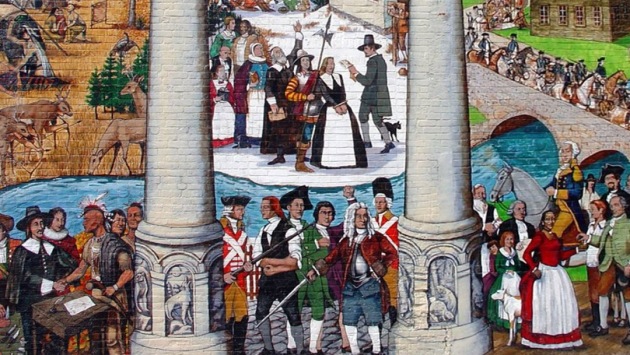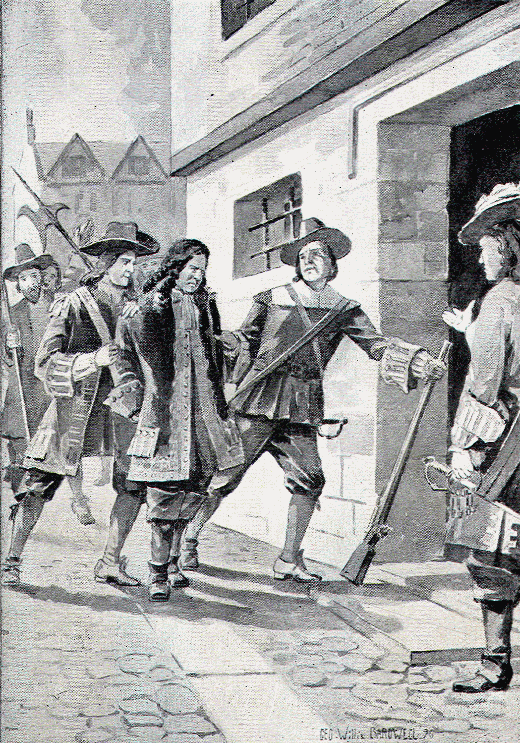The legendary and heroic opposition by the people and leaders of Ipswich to a tax imposed by the Crown in 1687 is commemorated in the seal of the town of Ipswich, which bears the motto, “The Birthplace of American Independence 1687.” This act of resistance has been called ‘the foundation of American Democracy,’ and was the beginning of a series of events that eighty-eight years later culminated in the Revolutionary War. The Ipswich town seal was designed by Arthur Wesley Dow and has appeared on Town Meeting warrants since 1895.
In the early 1680s, King Charles II of England revoked the charter of the Massachusetts Bay Colony in an attempt to bring the colonies more closely under crown control. In 1686 former governor of New York, Sir Edmund Andros, was appointed governor of a new “Dominion of New England” which included the Massachusetts, Connecticut, New Hampshire, and Rhode Island colonies. In 1688, its jurisdiction was expanded to include New York, and East and West Jersey. Andros invalidated existing land titles in Massachusetts, restricted town meetings, and actively promoted the Church of England in largely Puritan regions.

In 1687, John Andrews was chairman of the selectmen, the town clerk was John Appleton and the popular minister in Chebacco Parish Rev. John Wise was outraged. A born rabble-rouser, he jumped on his horse and flew from Chebacco Parish to call on brothers Sam and John Appleton. Along with several other town leaders they planned their strategy and in a hurriedly-called meeting the next day convinced residents to stand firm against unjust taxation and the loss of local rule. The town had already voted unanimously on Feb 11, 1685, against the surrender of the charter, and at this meeting refused to appoint a tax collector.
These were sturdy men whose ancestors had built Ipswich and were hardened veterans of King Philip’s War and the campaign against the French in Quebec. King Charles II had tossed out the colony’s charter and his successor James II placed a bureaucrat named Sir Edmund Andros in charge of a new “Dominion of New England.”
A town meeting was hastily organized the next day, and Mr. Wise addressed the assembled men with an impassioned address that is said to have greatly affected his audience. No copy of the speech is known to exist, but it moved the meeting to vote that “no taxes should be Levied upon the Subjects without consent of the Assembly chosen by the Freeholders.”
Passed unanimously at Ipswich Town meeting, Aug. 23, 1687
“Then considering that the said act doth infringe their Liberty as Free borne subjects of his Majestie by interfering with ye statutory Laws of the Land, By which it is enacted that no taxes shall be levied on ye Subjects without consent of an assembly chosen by ye Freeholders for assessing the same. They do, therefore, vote that they are not willing to choose a Commissioner for such an end without said privileges and moreover consent not that the Selectmen do proceed to lay any such rate until it be appointed by a General Assembly concurring with ye Governor and Counsel. Voted by the whole assembly twice.”
On September 19, a warrant was issued for the arrest of several Ipswich men for being “seditiously inclined and disaffected to his Majesty’s government.” Rev. John Wise, John Andrews, John Appleton, William Goodhue, Robert Kinsman, and Thomas French were arrested and tried before the court in Boston.
Major Samuel Appleton took refuge in Saugus, where he delivered an address denouncing Andros from a rocky cliff that is known today as “Appleton’s Pulpit.” Additional warrants were issued against him for “absconding himself.”
The leaders of the revolt in Ipswich based their defense on the Magna Carta of England, to which one of the judges asserted, “You must not think the laws of England follow us to the ends of the earth. Mr. Wise, you have no more privileges left you, than not to be sold as slaves.” They were returned to the jail and were fined heavily:
- Rev. John Wise, Fined 100£, Bond 1000£,
- John Andrews, Fined 50£, Bond 500£,
- John Appleton, Fined 30£, Bond 500£,
- Robert Kinsman, Fined 20£, Bond 500£,
- Wm. Goodhue, Jr., Fined 20£, Bond 500£,
- Thomas French Fined 15£, Bond 500£.
The men were kept in the Boston jail for a month and were released after the payment of all fines and costs, which were afterward repaid by the town of Ipswich. Samuel Appleton refused to pay bond, scorned even the appearance of submission, made no petition for bail, and refused to make any apology. He was kept prisoner from November until March in an unheated dungeon. Charges against other persons who had been arrested were dismissed.

Resistance leaders in neighboring towns were not treated as harshly. The book History of the Town and City of Gloucester, Cape Ann, Massachusetts by James Robert Pringle states that “among the rebellious towns was Gloucester and, as a result, seven of the prominent citizens were arraigned and fined at Salem for the refusal of the town to honor the terms of the warrant. The names of the citizens were William Haskell, James Stevens, Thomas Riggs, Selectman Thomas Millet, constable Timothy Somes, and William Sargent. All but Somes were fined 40 shillings each, to which one shilling was added for fees. Somes was discharged on the payment of fees.

News of the Ipswich resistance spread throughout the colony. Meanwhile, King James II was becoming increasingly unpopular in England and was overthrown in late 1688 by William, Prince of Orange, and his wife Mary as co-rulers. The news of the Glorious Revolution took a couple of months to reach Boston. A group of provincial militia and citizens gathered in Boston on April 18, 1689, surrounded Fort Mary, a garrison house on the city’s south side where Andros was quartered, and arrested several dominion officials as well as members of the Church of England who were suspected of sympathizing with the administration.

Major Samuel Appleton was among the men who helped escort Andros to Castle Island in Boston Harbor as a prisoner. Leaders of the former Massachusetts Bay Colony then reclaimed control of the government and rescinded the tax order. Simon Bradstreet resumed the governorship and was annually re-elected governor until 1692. Andros was shipped back to England. Rhode Island and Connecticut resumed governance under their earlier charters as well. It was a taste of things to come almost nine decades later in the Revolution of 1776.
Sources and further reading:
- Conceived in Liberty: Chapter 56: The Dominion of New England by Murray Newton Rothbard
- Journal of American History, page 440 by J. H Burnham
- Ipswich in the Massachusetts Bay Colony, Vol. 1, page 225, by Thomas Franklin Waters
- The Defiant Samuel Appleton




In the Post Office mural, which one is Samuel Appleton? One of his direct descendants wants to know.
We can’t be certain–we don’t have the artist’s notes. The Rev. John Wise is certainly the man dressed in black. Sam and John Appleton are the other two primary proponents. Sam Appleton was “elderly” compared to the others, so the artist probably portrayed him as the balding man in the orange jacket standing next to Wise, looking out at us. The person seated on the stool behind him would probably be John Appleton or John Andrews, the town clerk.